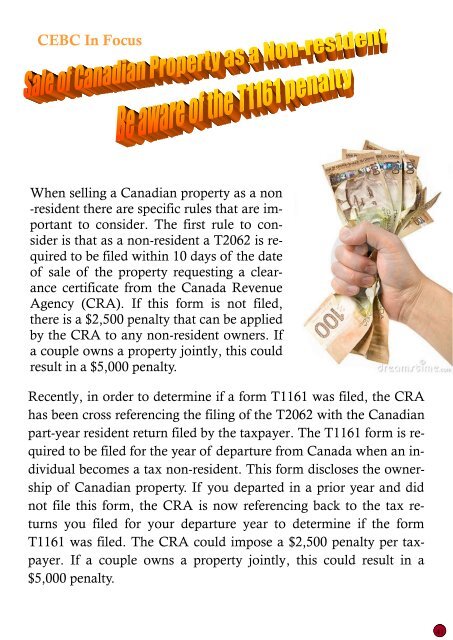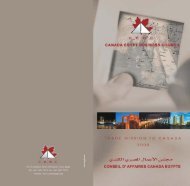June 13 - Canada Egypt Business Council
June 13 - Canada Egypt Business Council
June 13 - Canada Egypt Business Council
Create successful ePaper yourself
Turn your PDF publications into a flip-book with our unique Google optimized e-Paper software.
CEBC In Focus<br />
When selling a Canadian property as a non<br />
-resident there are specific rules that are important<br />
to consider. The first rule to consider<br />
is that as a non-resident a T2062 is required<br />
to be filed within 10 days of the date<br />
of sale of the property requesting a clearance<br />
certificate from the <strong>Canada</strong> Revenue<br />
Agency (CRA). If this form is not filed,<br />
there is a $2,500 penalty that can be applied<br />
by the CRA to any non-resident owners. If<br />
a couple owns a property jointly, this could<br />
result in a $5,000 penalty.<br />
Recently, in order to determine if a form T1161 was filed, the CRA<br />
has been cross referencing the filing of the T2062 with the Canadian<br />
part-year resident return filed by the taxpayer. The T1161 form is required<br />
to be filed for the year of departure from <strong>Canada</strong> when an individual<br />
becomes a tax non-resident. This form discloses the ownership<br />
of Canadian property. If you departed in a prior year and did<br />
not file this form, the CRA is now referencing back to the tax returns<br />
you filed for your departure year to determine if the form<br />
T1161 was filed. The CRA could impose a $2,500 penalty per taxpayer.<br />
If a couple owns a property jointly, this could result in a<br />
$5,000 penalty.<br />
41










